巴罗 宏观经济学ppt课件
合集下载
巴罗宏观经济学课件 (2)
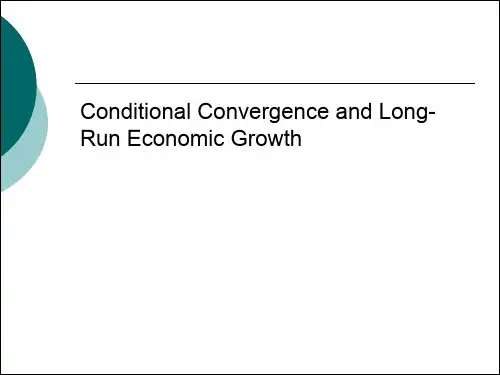
l exogenous technological progress the improvements in technology were not explained within the model.
¡ ∆A/A= g
Long-Run Economic Growth
¡ Exogenous Technological Progress
Endogenous Growth Theory
The basic R&D model
• Assumptions
1. The labor force is the single production factor
2. Generalized Cobb-Douglas function without capital
l Alternative opportunities for talented individuals: rent-seeking
l Learning-by-doing:
Endogenous Growth Theory
¡ Optimal intellectual property rights
¡ The Diffusion of Technology
l (y/k)*= δ+(1/s)·[n+g/(1−α)]
l For Cobb-Douglas function
1
k
s
n
sA
g /(1 )
1
Long-Run Economic Growth
Long-Run Economic Growth
Long-Run Economic Growth
Endogenous Growth Theory
¡ ∆A/A= g
Long-Run Economic Growth
¡ Exogenous Technological Progress
Endogenous Growth Theory
The basic R&D model
• Assumptions
1. The labor force is the single production factor
2. Generalized Cobb-Douglas function without capital
l Alternative opportunities for talented individuals: rent-seeking
l Learning-by-doing:
Endogenous Growth Theory
¡ Optimal intellectual property rights
¡ The Diffusion of Technology
l (y/k)*= δ+(1/s)·[n+g/(1−α)]
l For Cobb-Douglas function
1
k
s
n
sA
g /(1 )
1
Long-Run Economic Growth
Long-Run Economic Growth
Long-Run Economic Growth
Endogenous Growth Theory
巴罗 宏观经济学 ppt 章节9
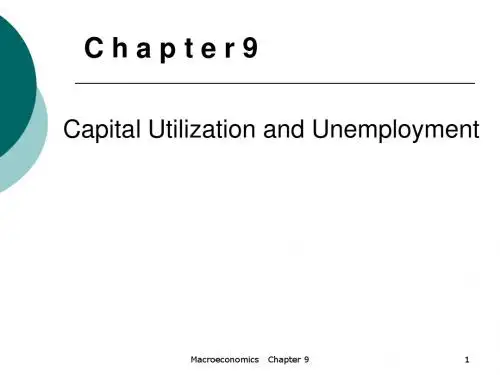
Macroeconomics
Chapter 9
28
The Labor Force, Employment, and Unemployment
Macroeconomics
Chapter 9
18
Capital Input
The Cyclical Behavior of Capacity Utilization
The Federal Reserve computes capacity utilization by expressing a sector’s output of goods as a percentage of the estimated “normal capacity” of each sector to produce goods
employment rate= 1 − u
Macroeconomics
Chapter 9
21
The Labor Force, Employment, and Unemployment
Employment =(1 − u)·Labor force
Total working hours = (1 − u)·Labor force ·working hours per worker
Macroeconomics Chapteroyment, and Unemployment
A Model of Job Finding
Macroeconomics
Chapter 9
27
The Labor Force, Employment, and Unemployment
Chapter 9
巴罗宏观经济学:现代观点第3章-PPT文档资料46页
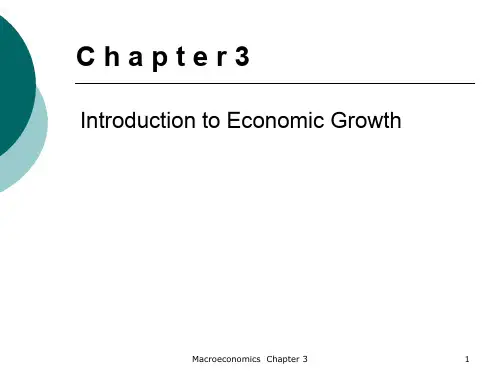
y=f(k)
y output per worker k capital per worker
Macroeconomics Chapter 3
19
Macroeconomics Chapter 3
20
An example: Cobb-Douglas Production Function
In particular, why did the East Asian countries do so much better than the subSaharan African countries?
Macroeconomics Chapter 3
11
Growth Questions
How did countries such as the United States and other OECD members sustain growth rates of real GDP per person of around 2% per year for a century or more?
Macroeconomics Chapter 3
32
Solow Growth Model
Y−δK=C+s·(Y−δ K) Real income = consumption + real saving
Macroeconomics Chapter 3
33
Solow Growth Model
Y = C + I Real GDP = consumption + gross
29
Solow Growth Model
∆Y/Y= α·(∆K/K) + (1−α)·(∆L/L) ∆Y/Y= α·(∆K/K) − α·(∆L/ L) + ∆L/ L ∆Y/Y − ∆L/L = α ·(∆K/K − ∆L/L) ∆y/y = α·(∆k/k)
y output per worker k capital per worker
Macroeconomics Chapter 3
19
Macroeconomics Chapter 3
20
An example: Cobb-Douglas Production Function
In particular, why did the East Asian countries do so much better than the subSaharan African countries?
Macroeconomics Chapter 3
11
Growth Questions
How did countries such as the United States and other OECD members sustain growth rates of real GDP per person of around 2% per year for a century or more?
Macroeconomics Chapter 3
32
Solow Growth Model
Y−δK=C+s·(Y−δ K) Real income = consumption + real saving
Macroeconomics Chapter 3
33
Solow Growth Model
Y = C + I Real GDP = consumption + gross
29
Solow Growth Model
∆Y/Y= α·(∆K/K) + (1−α)·(∆L/L) ∆Y/Y= α·(∆K/K) − α·(∆L/ L) + ∆L/ L ∆Y/Y − ∆L/L = α ·(∆K/K − ∆L/L) ∆y/y = α·(∆k/k)
巴罗宏观经济学课件 (3)
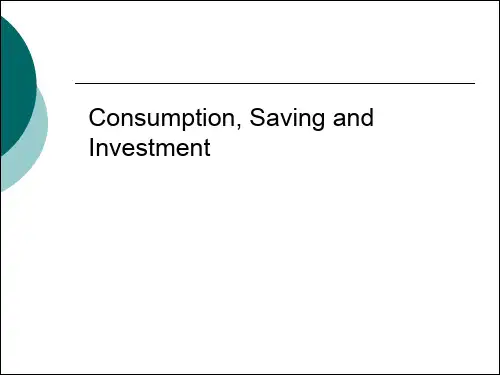
l The intertemporal-substitution effect motivates the household to save more when the interest rate rises.
Consumption and Saving
¡ The income effect from a change in the interest rate l C2 + ( B2/ P + K2) − ( B1/ P + K1) = ( w/ P) 2 · L + i1 · ( B1/ P + K1)
l If the interest rate, i1, is greater than zero, $1 received or spent in year 1 is equivalent to more than $1 in year 2.
l Dollars received or spent in year 2 must be discounted to make them comparable to dollars in year 1.
Consumption, Saving and Investment
Consumption and Saving
¡ Household budget constraint
l C + (1/P) · ∆B+ ∆K = π/P + ( w/P )·L + i·( B/P + K)
l π /P = 0 l C+(1/P)·∆B+∆K=(w/P)·L+i·(B/P+K) l consumption+ real saving = real income
Consumption and Saving
¡ The income effect from a change in the interest rate l C2 + ( B2/ P + K2) − ( B1/ P + K1) = ( w/ P) 2 · L + i1 · ( B1/ P + K1)
l If the interest rate, i1, is greater than zero, $1 received or spent in year 1 is equivalent to more than $1 in year 2.
l Dollars received or spent in year 2 must be discounted to make them comparable to dollars in year 1.
Consumption, Saving and Investment
Consumption and Saving
¡ Household budget constraint
l C + (1/P) · ∆B+ ∆K = π/P + ( w/P )·L + i·( B/P + K)
l π /P = 0 l C+(1/P)·∆B+∆K=(w/P)·L+i·(B/P+K) l consumption+ real saving = real income
巴罗宏观经济学课件 (10)
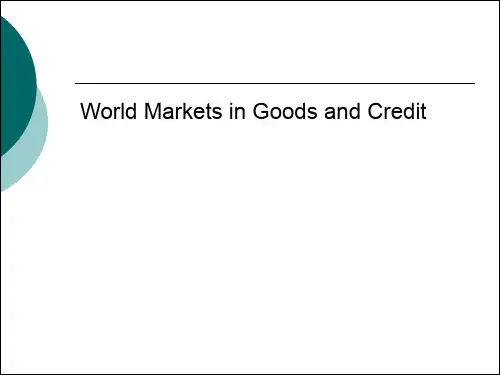
The Balance of International Payments
¡ (B ft − B ft−1 )/ P = Yt− ( Ct+ It+ Gt) + rt−1·Bft−1/P
¡ real current-account balance = trade balance + net real asset income
at rf
¡ The opening up to the world credit market would not change the real interest rate available to the home country’s households.
Determinants of the Current-Account Balance
The Balance of International Payments
¡ Ct+ It+ Gt + (B ft − B ft−1)/ P = Yt+ r t−1·B ft−1/ P
¡ real domestic expenditure+ net foreign investment = real GNP on goods and services
The Balance of International Payments
¡ Closed economy:
l Yt = Ct+ It+ Gt l real GDP = real domestic expenditure
The Balance of International Payments
¡ Open Economy
assets by the home country at the end of year t.
巴罗宏观经济学ppt11
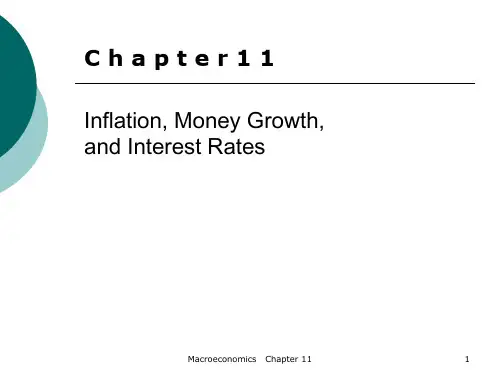
Two possible reasons of inflation:
Decrease of real demand for money Increase of money supply
Macroeconomics Chapter 11
2
Cross-Country Data on Inflation and Money Growth
Macroeconomics Chapter 11
16
Inflation and Interest Rates
Macroeconomics Chapter 11
17
Inflation and Interest Rates
Real and Nominal Interest Rates
The Real interest rate to be the rate at which the real value of assets held as bonds changes over time.
Denote by πe1 the expectation of the inflation rate π1.
The actual inflation rate, π1, will usually deviate from its expectatir—or unexpected inflation—will be nonzero.
π1 = ( P2 − P1)/ P1 π1 = ∆P1/ P1
Macroeconomics Chapter 11
12
Inflation and Interest Rates
Actual and Expected Inflation
π1 = ( P2 − P1)/ P1 π1 = ∆P1/ P1 π1 ·P1 = P2 − P1
Decrease of real demand for money Increase of money supply
Macroeconomics Chapter 11
2
Cross-Country Data on Inflation and Money Growth
Macroeconomics Chapter 11
16
Inflation and Interest Rates
Macroeconomics Chapter 11
17
Inflation and Interest Rates
Real and Nominal Interest Rates
The Real interest rate to be the rate at which the real value of assets held as bonds changes over time.
Denote by πe1 the expectation of the inflation rate π1.
The actual inflation rate, π1, will usually deviate from its expectatir—or unexpected inflation—will be nonzero.
π1 = ( P2 − P1)/ P1 π1 = ∆P1/ P1
Macroeconomics Chapter 11
12
Inflation and Interest Rates
Actual and Expected Inflation
π1 = ( P2 − P1)/ P1 π1 = ∆P1/ P1 π1 ·P1 = P2 − P1
宏观经济学ppt课件完整版
一、国内生产总值的定义
•
定义:在某一既定时期一国之内生
产的所有最终产品和劳务市场价值总
和。
•
上述定义包括以下几方面规定:
•
第一,“一国之内…”。GDP按国
土原则计算
•
GDP以领土为统计范围,强调无
论劳动力和其它生产要素是属于本
国、还是外国,只要是在本国领土
生产的产品和劳务的价值都计入本
国的GDP。,
企业家愿意提供的产品越多。
•
—— 供给定理
34
(2)经济理论的图形表达
P
S
O
Q
35
(3)经济理论的数学表达
•
•
•
•
用函数的形式表达供给定理,该理
论可以表示为:
Q
= f(P)
供给量
价格
函数
上式表示供给量是价格的函数。
36
(4)著名的经济学模型 :供求模型
•
例如,猪肉的需求函数:
•
Qd = D(P、Y)
流量而不是存量,通常以年度或季
度为单位度量。
存量 VS .流量
•
存量:
在某一时点上存在的数量。
(洗脸盆中的水,你书架上的书和
你储蓄账户上的货币量也是存量。)
•
流量:
在一定时期发生的量。
(打开的水龙头流到洗脸盆中的水。
我们在一个月里买的书和我们在一个
月里赚到的收入也是流量。)
存量 VS .流量
•
化等。
26
值得研究的问题:
•
(1)为什么会有经济增长?决定因
素是什么?
•
(2)如何准确测量经济增长的速度
和成本,经济增长如何维持?如何实
巴罗宏观经济学课件 (5)
Temporary Changes in Government Purchases
¡ Theory
l Assume now that year 1’s real government purchases, G1, rise by one unit, while those for other years, Gt, do not change. That is, everyone expects that Gt in future years will return to the original level.
¡ Intratemporal substitution effect involves consumption and leisure:
l labor and, hence, leisure is fixed. l In any event, this substitution effect depends on
Permanent Changes in Government Purchases
l r = ( R/ P) · κ − δ(κ)
l a permanent increase in government purchases does not affect the real interest rate.
The Government’s Budget Constraint
¡ Gt represent government purchases in real terms for year t. l Ct + It + Gt, is the aggregate real spending on goods and services in year t.
宏观经济学全集PPT课件
02
国民收入核算与决定
国民收入核算体系与方法
01
02
03
GDP核算体系
以国内生产总值(GDP) 为核心的核算体系,包括 生产法、收入法和支出法 三种核算方法。
GNP核算体系
以国民生产总值(GNP) 为核心的核算体系,注重 国民经济总体规模和结构。
国民经济核算账户
通过一系列账户体系全面 反映国民经济运行状况, 包括生产账户、收入分配 账户、消费账户等。
开放经济条件下财政政策效应分析
财政政策效应
指财政政策实施过程中对经济社会所产生的影响和效果。在开放经济条件下,财政政策效 应会受到多种因素的影响,如国际资本流动、汇率变动、国际贸易等。
财政政策与国际贸易
财政政策可以通过调整关税、出口退税等措施来影响国际贸易,进而对国内经济产生影响 。例如,提高关税可以保护国内产业,但同时也可能导致贸易伙伴采取报复措施,影响国 际贸易环境。
• 总供给曲线:表示在其他条件不变的情况下,价格水平与总供给量之间的关系 。总供给曲线通常向右上方倾斜,表明随着价格水平的提高,总供给量也会增 加。
• 总需求曲线:表示在其他条件不变的情况下,价格水平与总需求量之间的关系 。总需求曲线通常向右下方倾斜,表明随着价格水平的提高,总需求量会减少 。
• 模型分析:当总供给曲线与总需求曲线相交时,经济达到均衡状态。此时的价 格水平和产出水平分别为均衡价格和均衡产出。当经济受到外部冲击时,如财 政政策变动、国际经济环境变化等,总供给曲线或总需求曲线会发生移动,导 致均衡价格和均衡产出发生变化。通过对总供给-总需求模型的分析,可以预 测和解释这些变化对宏观经济的影响。
THANKS
感谢观看
工具选择考虑因素
经济形势、政策目标、工具特点 等。
巴罗宏观经济学:现代观点第10章42页PPT
Steven Goldfeld
Casey Mulligan and Xavier Sala-iMartin
Michael Dotsey
Macroeconomics Chapter 10
18
Determination of the Price Level
The Nominal Quantity of Money Supplied Equals the Nominal Quantity Demanded
Checkable deposits issued by banks and other financial institutions.
Macroeconomics Chapter 10
4
Macroeconomics Chapter 10
5
Macroeconomics Chapter 10
6
Macroeconomics Chapter 10
24
Determination of the Price Level
A Change in the Nominal Quantity of Money
The unchanged technology level, A, means that the real rental price, R/P, and the quantity of capital services, κK, do not change.
Macroeconomics Chapter 10
7
The Demand for Money
Money is hand-to-hand currency
Assume that the interest rate paid on money is zero.
- 1、下载文档前请自行甄别文档内容的完整性,平台不提供额外的编辑、内容补充、找答案等附加服务。
- 2、"仅部分预览"的文档,不可在线预览部分如存在完整性等问题,可反馈申请退款(可完整预览的文档不适用该条件!)。
- 3、如文档侵犯您的权益,请联系客服反馈,我们会尽快为您处理(人工客服工作时间:9:00-18:30)。
There is a broad cross-sectional range for the inflation rates and the growth rates of money.
7
Cross-Country Data on Inflation and Money Growth
Highlights
We measure the price level, P, by the consumer price index (CPI). We use the CPI, rather than the GDP deflator, because of data availability.
3
4
5
6
Cross-Country Data on Inflation and Money Growth
Actual and Expected Inflation
Since the future is unknown, households have to form forecasts or expectations of inflation.
Denote by πe1 the expectation of the inflation rate π1.
For a country that has a high inflation rate in one period to have a high inflation rate in another period.
Strong positive association between the inflation rate and the growth rate of nominal currency.
9
Cross-Country Data on Inflation and Money Growth
10
Cross-Country Data on Inflation and Money Growth
One lesson from the cross-country data is that, to understand inflation, we have to include money growth as a central part of the analysis.
12
Inflation and Interest Rates
Actual and Expected Inflation
π1 = ( P2 − P1)/ P1 π1 = ∆P1/ P1 π1 ·P1 = P2 − P1 P2 = ( 1 +π1) ·P1
13
Inflation and Interest Rates
Highlights
The inflation rate was greater than 0 for all countries from 1960 to 2000
The growth rate of nominal currency was greater than 0 for all countries from 1960 to 2000.
Chapter11 Inflation, Money Growth, and Interest Rates
1
Cross-Country Data on Inflation and Money Growth Key equation: Ms = P·L(Y, i)
Two possible reasons of inflation:
Milton Friedman’s famous dictum:
“Inflation is always and everywhere a monetary phenomenon.”
11
Inflation and Interest Rates
Actual and Expected Inflation
8
Cross-Country Data on Inflation and Money Growth
Highlights
In most countries, the growth rate of nominal currency, M, exceeded the growth rate of prices.
The median inflation rate from 1960 to 2000 was 8.3% per year, h 30 countries exceeding 10%.
For the growth rate of nominal currency, the median was 11.6% per year, with 50 above 10%
Let π be the inflation rate. The inflation rate from year 1 to year 2, π1, is the ratio of the change in the price level to the initial price level.
π1 = ( P2 − P1)/ P1 π1 = ∆P1/ P1
Decrease of real demand for money Increase of money supply
2
Cross-Country Data on Inflation and Money Growth
Inflation rates and money growth rates for 82 countries from 1960 to 2000.
The actual inflation rate, π1, will usually deviate from its expectation, πe1, and the forecast error—or unexpected inflation—will be nonzero.
14
Inflation and Interest Rates
7
Cross-Country Data on Inflation and Money Growth
Highlights
We measure the price level, P, by the consumer price index (CPI). We use the CPI, rather than the GDP deflator, because of data availability.
3
4
5
6
Cross-Country Data on Inflation and Money Growth
Actual and Expected Inflation
Since the future is unknown, households have to form forecasts or expectations of inflation.
Denote by πe1 the expectation of the inflation rate π1.
For a country that has a high inflation rate in one period to have a high inflation rate in another period.
Strong positive association between the inflation rate and the growth rate of nominal currency.
9
Cross-Country Data on Inflation and Money Growth
10
Cross-Country Data on Inflation and Money Growth
One lesson from the cross-country data is that, to understand inflation, we have to include money growth as a central part of the analysis.
12
Inflation and Interest Rates
Actual and Expected Inflation
π1 = ( P2 − P1)/ P1 π1 = ∆P1/ P1 π1 ·P1 = P2 − P1 P2 = ( 1 +π1) ·P1
13
Inflation and Interest Rates
Highlights
The inflation rate was greater than 0 for all countries from 1960 to 2000
The growth rate of nominal currency was greater than 0 for all countries from 1960 to 2000.
Chapter11 Inflation, Money Growth, and Interest Rates
1
Cross-Country Data on Inflation and Money Growth Key equation: Ms = P·L(Y, i)
Two possible reasons of inflation:
Milton Friedman’s famous dictum:
“Inflation is always and everywhere a monetary phenomenon.”
11
Inflation and Interest Rates
Actual and Expected Inflation
8
Cross-Country Data on Inflation and Money Growth
Highlights
In most countries, the growth rate of nominal currency, M, exceeded the growth rate of prices.
The median inflation rate from 1960 to 2000 was 8.3% per year, h 30 countries exceeding 10%.
For the growth rate of nominal currency, the median was 11.6% per year, with 50 above 10%
Let π be the inflation rate. The inflation rate from year 1 to year 2, π1, is the ratio of the change in the price level to the initial price level.
π1 = ( P2 − P1)/ P1 π1 = ∆P1/ P1
Decrease of real demand for money Increase of money supply
2
Cross-Country Data on Inflation and Money Growth
Inflation rates and money growth rates for 82 countries from 1960 to 2000.
The actual inflation rate, π1, will usually deviate from its expectation, πe1, and the forecast error—or unexpected inflation—will be nonzero.
14
Inflation and Interest Rates
